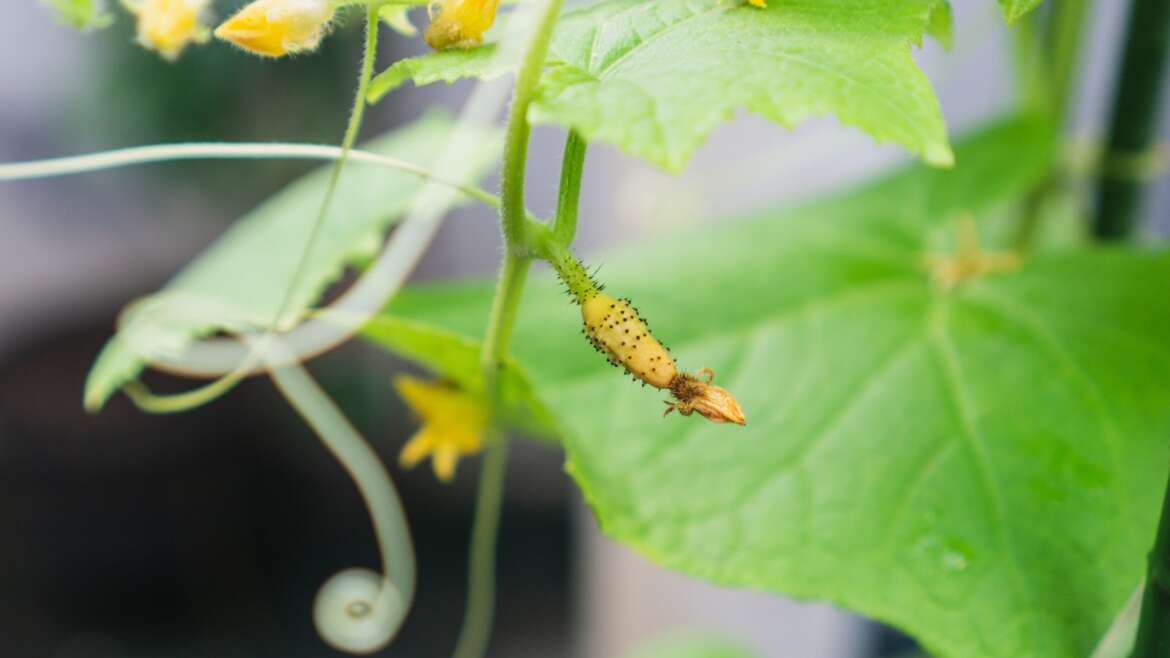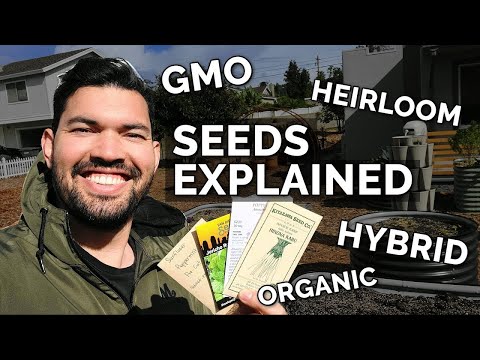When you plant cucumbers in your garden, you probably envision loading up your harvest basket with straight, uniform-looking cucumbers. But this isn’t always what happens! Gardeners across the world have walked out into their cucumber patches to find cucumbers with a spiral shape, pinched end, or otherwise misshapen appearance.
While these funny-shaped cucumbers are safe to eat, they’re not always what gardeners desire. Slicing curvy cucumbers proves challenging, and cukes with pinched ends often go hand-in-hand with a bitter taste. However, growing straight cucumbers is often easier said than done!
Learning the causes of misshapen cucumbers is the first step in knowing how to grow straight fruits. I’ll cover seven reasons why your cucumbers may look funny and provide ways to remedy these causes.
Lack of Pollinators
Cucumber flowers depend on bees to pollinate them.
Incomplete pollination is one of the most common causes of misshapen cucumber, and a lack of pollinators is one of the main causes of incomplete pollination. You may be wondering how a flower can be partially pollinated. After all, doesn’t a bee just visit a flower, collect pollen, and carry it to another flower? In some cases, yes. But not all the time!
Since cucumber flowers have large, sticky pollen, wind pollination isn’t possible. Instead, the plants rely on pollinators (mainly bees) to transfer pollen from a male cucumber flower to a female flower. Each pollen grain forms a single seed, so pollinators must transfer hundreds of pollen grains to the female flower in order for complete pollination to occur. In fact, researchers have found that it takes about nine bee visits per flower for complete pollination to occur!
If only two or five bees visit a cucumber flower, the cucumber fruit won’t fully develop. The result is small, curled, or otherwise misshapen fruit. Incomplete pollination often causes cucumbers that are full and normal-looking on one end and a pointed knob on the other end. And if flowers aren’t pollinated at all, the flowers won’t form fruit.
A good way to remedy a lack of pollinators is to plant flowering plants that are rich in nectar and pollen. These plants will draw in bees and encourage them to visit your cucumber plants. Perennial flowers like bee balm, anise hyssop, and coneflower supply pollen and nectar over multiple months. If you don’t want to add perennials, try adding some annuals like calendula, sweet alyssum, sunflowers, and basil.
You should also avoid using broad-spectrum insecticides that harm bees and other pollinators. If you use insecticides, choose a product that impacts only the target pest and apply it in the early morning or evening.
High Temperatures
 Extreme heat reduces fruit quality due to decreased pollinator activity.
Extreme heat reduces fruit quality due to decreased pollinator activity.
While cucumbers are heat-loving crops, extremely high temperatures can disrupt pollen production. Plants may stop producing pollen, produce pollen with lower viability, or fail to release pollen so it’s available to pollinators. Even if plenty of pollinators visit your flowers, proper pollination may not occur.
Therefore, high temperatures often lead to decreased pollination rates. When pollinators fail to adequately pollinate the flowers, the resulting fruits end up curved, curled, or otherwise distorted. Temperatures above 90°F (32°C) are hot enough to cause problems with pollen and, therefore, pollination.
These high temperatures also encourage monoecious plants (those with both male and female flowers) to produce a higher percentage of male flowers. While this may increase pollination rates, it often decreases overall harvest since only female flowers can produce fruit.
High temperatures also slow bee activity, which decreases pollination rates. When unhealthy pollen is combined with low pollinator activity, it’s not surprising to see misshapen fruits.
So, what can you do about this? One option is to plant parthenocarpic cucumber varieties like ‘Telegraph Improved’ and ‘Hokus Gherkin.’ These plants will produce fruit without pollination, so you don’t have to worry about hot weather disturbing fruit production. You can also take a break from cucumber production during the heat of summer if you live in a warm growing zone.
Low Temperatures
 Cold temperatures hinder pollen production in plants.
Cold temperatures hinder pollen production in plants.
/Since cucumbers prefer warm temperatures, cold temperatures can also lead to problems with fruit development. Warm weather is one factor that lets cucumber plants know it’s time to form flowers instead of new vegetative growth. If the temperature consistently drops below 60°F (16°C), the plants may never develop flowers.
Even if plants develop flowers, cold temperatures inhibit pollen production, which limits successful pollination. Colder temperatures also encourage plants to produce a larger proportion of female flowers and limit the number of male flowers. This high ratio of female to male flowers also decreases the odds of successful germination.
Cold weather also often limits bee activity. If bees are hunkering down during cold temperatures, there’s a lower chance they’ll adequately pollinate cucumber flowers. This incomplete pollination may result in curved or knobby fruits.
With this information in mind, avoid planting cucumbers until nighttime temperatures are consistently above 60°F (16°C). These temperatures will limit plant stress and ensure pollinators are out and about.
Lack of Water
 An inconsistent water supply during cucumber fruit formation leads to misshapen fruits.
An inconsistent water supply during cucumber fruit formation leads to misshapen fruits.
I probably don’t need to tell you that cucumbers consist almost entirely of water. If the plants don’t have access to enough moisture, they become stressed, and the fruits become misshapen.
Cucumbers require a moderate amount of water during all seasons, but they need an extra high amount on hot and sunny days. When the weather is hot, plants rely on a process called transpiration to cool themselves. You can think of transpiration as the plant equivalent of sweating; the plants lose water through their leaves, cooling themselves in the process. This water loss is why plants require more water during hot weather.
If cucumber plants can’t access a consistent amount of water as they form fruits, the fruits often end up fat on one end and skinny on the other. This occurs if the plants have an adequate amount of water during the first half of fruit formation and not enough water during the second half of fruit development.
One way to make sure your cucumber plants receive enough water is to set up a drip irrigation system. Drip irrigation supplies water directly to the ground, limiting water loss through evaporation and keeping cucumber leaves dry. It also allows you to easily set up your irrigation on a timer, ensuring your plants get watered even when you’re away longer than expected. Since the amount of water you should apply depends on rainfall, temperature, wind, and more, make sure to adjust your watering schedule as necessary.
Variety Selection
 Growing ‘Marketmore’ cucumbers on a trellis promotes straight fruit.
Growing ‘Marketmore’ cucumbers on a trellis promotes straight fruit.
While many people imagine straight slicing or pickling cucumbers when they imagine these crunchy snacks, you can find a wide range of cucumber varieties. Some of these cucumbers are more likely to produce curved cucumbers, and these oddly-shaped fruits are nothing to worry about. For example, varieties like ‘Tasty Green’ and ‘Suyo Long’ often produce cucumbers that are curved or larger on one side than the other.
If you want to increase your chances of ending up with straight cucumbers, choose classic slicing varieties like ‘Marketmore’ and ‘Bristol.’ Growing any type of cucumber plant on a trellis will also increase the odds of straight fruit. Gravity will pull the cucumbers down and encourage the fruits to grow straight.
Presence of Pollinators
 Parthenocarpic cucumbers are best grown in pollinator-free environments like high tunnels.
Parthenocarpic cucumbers are best grown in pollinator-free environments like high tunnels.
While most cucumber plants require pollinators in order to produce healthy cucumbers, pollination can actually cause problems with some cucumbers. Parthenocarpic varieties produce fruits even if their flowers aren’t properly pollinated. In fact, pollination can even cause issues with fruit production!
If the flowers of parthenocarpic cucumbers become pollinated, the fruits may be small or funny-shaped. Therefore, parthenocarpic varieties are best grown in high tunnels, greenhouses, or other locations free from pollinators.
You can also look for varieties that are both parthenocarpic and gynoecious. Gynoecious cucumbers contain only, or primarily, female flowers. When there are no male flowers present, the female flowers remain unpollinated.
Physical Injury
 Certain constraints during growth can cause fruits to develop misshapen features.
Certain constraints during growth can cause fruits to develop misshapen features.
As cucumbers grow, they readily adapt to their surrounding environment. If a plant stem or piece of trellis wire stands in a cucumber’s way, the cucumber will grow around the object rather than stop growing. This often results in oddly shaped cucumbers.
For example, let’s say a tiny cucumber fruit starts growing between a wall and a taut piece of string used for trellising. As the fruit grows, it will become constricted by the string and the wall. This may lead the fruit to develop a sharp indent where the string was and/or a flat side where it grew against the wall.
This cause of misshapen fruits typically only affects a small amount of cucumbers. So, if you notice a lot of your cucumbers are misshapen, something else is likely to blame.
Damage from pests like cucumber beetles can also cause physical injury. However, these pests will cause small bite marks on the cucumber’s skin rather than entirely misshapen fruits.
Final Thoughts
The next time you see a curvy or stubby cucumber, don’t panic! Instead, think about what could have caused this odd appearance. Poor pollination is the most likely cause, but any of the factors listed above could be to blame.



